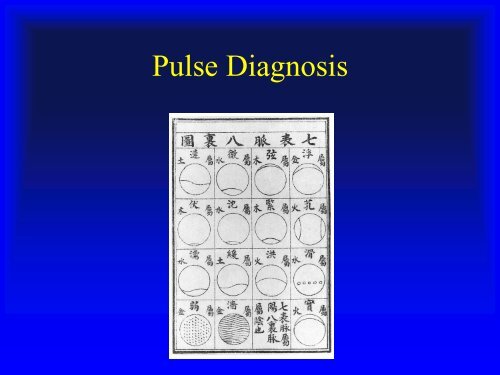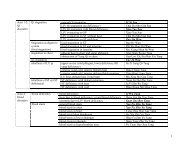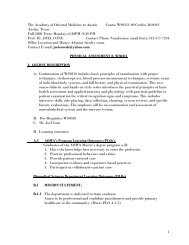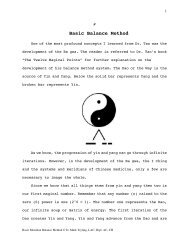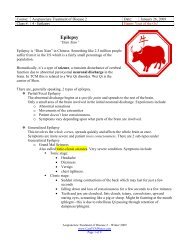Create successful ePaper yourself
Turn your PDF publications into a flip-book with our unique Google optimized e-Paper software.
Basics• Time• Posture• Placement of fingers• Simple finger techniques
Ultra Basics• Tubes• Pump• Fluid• Ground substance
Ideal <strong>Pulse</strong>• Has Root• Has Stomach Qi (moderation)• Has Shen: Stability - rate - amplitude• Other factors– Matches Season - local influences play as well– Matches Position– Evenly distributed between positions
Technique• Thenar eminence• Relaxed• Level of the heart• Finger tips to the bed of the fingers – findthe most sensitive area• Thumb opposed
Fingers Are a Unit• Global• Each Depth• Each Side• Each BurnerThis is the primary way to assess a region
Sectional ViewsFingers Function As Filters• Three Depths• Two Sides• Three Burners
Three Depths• Qi: nerves• Blood: vessels• Organ: organ tissue
Sides• Left– Organs– Constitution– Prenatal– Blood• Right– Digestion– Acquired status– Postnatal– Qi
• Left side FeebleOrgan System
Digestive System• Right Side uniform - Tight, Feeble
Burners• If the pulse quality is the same on both sidesand is only in the upper middle or lowersection – it is an issue related to the wholeburner.• Ie. Slippery in both middle positions:dampness or damp and heat in the middleburner
<strong>Pulse</strong> Qualities
Three Basic DivisionsForm Time TraitImage Floating Deep Slow Rapid Weak Strong
Moderate <strong>Pulse</strong> (huan mai)• denotes a pulse that is ideal in terms ofform, process and trait. That is the shape iseven, the rate is moderate and the wavescome and go in a relaxed and even fashion.The vessel wall is neither hard nor yieldingand the force is moderate.
Floating <strong>Pulse</strong> (fu mai)• a pulse that is felt superficially with thefingers resting lightly on the skin. The forcedecreases slightly in the deeper level but theroot is still present.
Floating <strong>Pulse</strong> – Without Root in theMiddle Position
Deep <strong>Pulse</strong> (chen mai):• A pulse that is found when pressing to theorgan depth. There is little sensation withlight pressure.
Deep in the Middle Position
Slow <strong>Pulse</strong> (chi mai)• denotes a pulse that is between 40 and 60beats per minute.
Rapid <strong>Pulse</strong> (suo mai)• denotes a pulse that is between 90 and 140beats per minute.
Excess <strong>Pulse</strong> (shi mai)• denotes a pulse that is felt in all the threepositions and depths. It feels full. Thisimpression is generated by the long, largeand forceful character of the pulse.• It has force
Deficient <strong>Pulse</strong> (xu mai)• denotes a pulse shape that is large and soft,without force.• It lacks force
Big <strong>Pulse</strong> (da mai)• denotes a pulse that is wide and thick.
Thready <strong>Pulse</strong> (shi mai)• denotes a pulse that is very thin. It has definitionand feels like a fine thread.
Long <strong>Pulse</strong> (chong mai)• denotes a pulse that is smooth and straight andextends beyond the three positions.
Short <strong>Pulse</strong> (duan mai)• denotes a pulse that is not felt in all thethree positions. It is absent in one or both ofthe distal and proximal positions.
Short <strong>Pulse</strong>
Surging <strong>Pulse</strong> (hong mai)• denotes a pulse that arrives with force anddeparts without force. Overall, it is largeand forceful like a wave. <strong>Pulse</strong> is broad,large and forceful like roaring wave whichcome on powerfully and fade away.
Surging <strong>Pulse</strong>
Slippery <strong>Pulse</strong> (hua mai)• denotes a pulse that slides quickly andsmoothly under the fingers. It is one of themost commonly identified pulse images.The fingers must press into the blood streamin order to feel this pulse. It can be palpatedsuperficially and in the depths, but it is mostcommon in the middle of the blood stream.
Slippery <strong>Pulse</strong> (hua mai)
Slippery <strong>Pulse</strong> (hua mai)
Choppy <strong>Pulse</strong> (se mai):• denotes a pulse that is rough and notsmooth. It involves irregular form, processand traits. That is, rhythm, force and shape.The shape of the vessels or the wave can berough. The amplitude of the waves canchange due to uneven force. The unevenrhythm is a “changing rate at rest.”
Wiry <strong>Pulse</strong> (xuan mai)• denotes a pulse that feels tense, long andstable. It can be felt with varying levels ofpressure. A wiry pulse passes straight underthe fingers and can be highlighted by rollingthe fingers along the surface of the vessel. Itis much like a violin string, and can bedivided into excess (shi), deficient (shu) andmoderate (bing), corresponding to thicker orthinner strings.
Hurried <strong>Pulse</strong> (cu mai)• denotes a pulse that is rapid and irregularlyirregular. It is agitated and urgent, like aman running and stumbling.
Knotted <strong>Pulse</strong> (jie mai)• denotes a pulse that is slow and irregularlyirregular. is slow with irregularintermittence. After the missed beating, thepulse continues immediately.
Intermittent <strong>Pulse</strong> (dai mai)• denotes a pulse that misses a beat at regularintervals, and the more frequent the missedbeat, the more serious the pathology.
Soggy <strong>Pulse</strong> (ru mai)• denotes a pulse that is floating, thready andsoft. It feels like a piece of thread floatingon water. There is no force and gives waywith pressure.
Hollow <strong>Pulse</strong> (kong mai)• denotes a pulse that is wide and soft vesselwhen lightly touched, and hollow whenseeking. It can truly be said to be vacuous.There is a three dimensional field ofhollowness in the center as one presses andseeks. With pressure, the edges of vessel areclearly felt, the center is obscure.
Leather <strong>Pulse</strong> (ge mai)• denotes a pulse that is wide and the vesselwall is thick. It is felt superficial withoutroot, or hollow.
Scattered <strong>Pulse</strong> (san mai):• denotes a pulse that is large, floating and weak.The wall of the vessel is very thin and it spreadslike powder in the wind when touched. It lacksforce and the form is unclear, the boundarybetween vessel and the ground substance is vague.The pulse easily disappears when pressing orsearching. This causes the rate to be difficult tocount if the scattered quality is global.
Vessel Wall
Hidden <strong>Pulse</strong> (fu mai)• denotes a pulse that cannot be felt withnormal palpation such as touching, seekingor pressing. It can only be felt whenpressing to the bone, or under the tendon.Pathogens obstruct interior
Firm <strong>Pulse</strong> (lao mai):• denotes a pulse that is deep, bowstring, andforceful. It is stable and lacks normalvariability.
Weak <strong>Pulse</strong> (ruo mai):• denotes a pulse that is yielding, deep andthin. It can only be felt in deep level bepressing. If more strength is put, the pulse isvague.
Minute <strong>Pulse</strong> (wei mai)• denotes a vessel that is thin and soft to thepoint of absence. Hammer calls this pulsefeeble-absent.
Tight <strong>Pulse</strong> (jin mai)• Tense• Force• Twisted like a rope• Moves side to side
Moving <strong>Pulse</strong> (dong mai)• denotes a pulse that is very short and urgent.It can be slippery or have rough vibrations.There is no arrival or departure. It is like ajumping bean. It is most often felt in the leftmiddle positions.
Moving (dong mai)
Racing <strong>Pulse</strong> (ji mai)• denotes a pulse that is over 140 beats perminute. It is an extreme condition.
Interpretation• Location = structure• Quality = process• Method– Dominant impressions– Detailed and sequential analysis• Label• Interpret• Aggregate (mind map)
Generally:• Force = deficiency or excess• Width = blood• Amplitude = qi and yang• Hardness = yin deficiency• Urgency = heat
Pathogens• Cold = tight, slow• Wind = floating (ext) changing (int)• Heat and fire = surging, urgent, rapid• Damp = slippery, cotton, moist skin• Dryness = skin• Summer heat = floating, rapid, slippery
<strong>Pulse</strong> Diagnosis is a Lifetime Study


